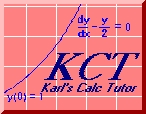

The problem was to find the limit of
lim xx
x > 0+
and the hint was that
lim ex ln(x) = elim x ln(x)
which is why we need only find the limit of Step 1: Write it as a quotient. The thing we are taking the limit of is, right now, expressed as a product. We need to write it as a quotient.
ln(x)
lim x ln(x) = lim
x > 0+ x > 0+ 1
x
Step 2: What do numerator and denominator go to in the limit?
The denominator, 1/x, clearly grows without limit as x
approaches zero -- that is 1/x goes to infinity. The function,
ln(x) is not defined at
Step 3: Find the derivatives the numerator and denominator. We know that the derivative of ln(x) is 1/x. And the derivative of 1/x is -1/x2.
Step 4: Apply L'Hopital's Rule. Which means that
1
ln(x) x
lim = lim
x > 0+ 1 x > 0+ -1
x x2
Step 5: Take the limit. First multiply top and bottom by -x2. Now you have
ln(x)
lim = lim -x
x > 0+ 1 x > 0+
x
The limit as x approaches zero of -x is zero. So you end
up with
ln(x)
lim = 0
x > 0+ 1
x
Now recall that what we were really looking for was the limit as x
approaches zero of ex ln(x). And from the above
calculations, that limit would have to be
lim xx = 1
x > 0+
If your calculator has an exponentiation function, you can try raising
a small positive x like 0.0000001 to itself and see
for yourself what the trend is.
email me at hahn@netsrq.com